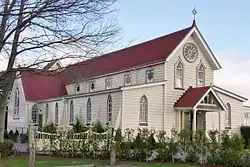Meeanee, New Zealand
Meeanee is a locality south of the city of Napier, in the Hawke's Bay Region on the east coast of New Zealand's North Island. It was named after the Battle of Meeanee in India (now spelled Miani, but the area has retained the older spelling), won by Sir Charles Napier, the city's namesake.[1] Along with such locations as Clive and Havelock North, it is one of several places within Hawke's Bay to be named for colonial Indian events or people.
Meeanee | |
|---|---|
Suburb of Napier | |
 St. Mary's Church, Meeanee. | |

| |
| Coordinates: 39.544°S 176.893°E | |
| Country | New Zealand |
| Region | Hawke's Bay Region |
| Territorial authority | Napier City |
| Ward | Taradale |
| Named for | Battle of Meeanee[1] |
| Elevation | 0–3 m (0–10 ft) |
| Population (2018 Census)[2] | |
| • Total | 2,541 |
| Time zone | UTC+12 (NZST) |
| • Summer (DST) | UTC+13 (NZDT) |
| Postcode | 4112 |
| Area Code | 06 |
History
Meeanee was the only access inland to Taradale until the road was built in 1873, and was the site of a Catholic Marist mission station from the 1850s.[3] The priests introduced viticulture to the Hawke's Bay region, planting several vineyards and establishing the Mission Estate Winery in 1851, New Zealand's oldest surviving winemaking concern.[4] They also built St Mary's Church in 1863, which still stands but is now a privately owned restaurant and event venue.[5]
Economy

Meeanee is located on the flat coastal plain south of Napier, and surrounded by farmland and apple orchards.
Demographics
| Year | Pop. | ±% p.a. |
|---|---|---|
| 2006 | 1,494 | — |
| 2013 | 1,932 | +3.74% |
| 2018 | 2,541 | +5.63% |
| Source: [2] | ||
The statistical area of Meeanee-Awatoto, which at 24 square kilometres is larger than this settlement, and also includes Te Awa and Awatoto, had a population of 2,541 at the 2018 New Zealand census, an increase of 609 people (31.5%) since the 2013 census, and an increase of 1,047 people (70.1%) since the 2006 census. There were 891 households. There were 1,293 males and 1,248 females, giving a sex ratio of 1.04 males per female. The median age was 43.7 years (compared with 37.4 years nationally), with 471 people (18.5%) aged under 15 years, 399 (15.7%) aged 15 to 29, 1,221 (48.1%) aged 30 to 64, and 444 (17.5%) aged 65 or older.
Ethnicities were 87.5% European/Pākehā, 14.4% Māori, 3.1% Pacific peoples, 4.5% Asian, and 2.6% other ethnicities (totals add to more than 100% since people could identify with multiple ethnicities).
The proportion of people born overseas was 15.0%, compared with 27.1% nationally.
Although some people objected to giving their religion, 53.4% had no religion, 35.3% were Christian, 0.5% were Hindu, 0.1% were Muslim, 0.2% were Buddhist and 3.4% had other religions.
Of those at least 15 years old, 381 (18.4%) people had a bachelor or higher degree, and 327 (15.8%) people had no formal qualifications. The median income was $37,400, compared with $31,800 nationally. The employment status of those at least 15 was that 1,137 (54.9%) people were employed full-time, 309 (14.9%) were part-time, and 60 (2.9%) were unemployed.[2]
Education
Meeanee School is a co-educational Year 1-8 state primary school,[6] with a roll of 85 as of March 2020.[7][8]
References
- "St Thomas' Anglican Church". Heritage New Zealand. Retrieved 8 December 2019.
- "Statistical area 1 dataset for 2018 Census". Statistics New Zealand. March 2020. Meeanee-Awatoto (215400). 2018 Census place summary: Meeanee-Awatoto
- Pollock, Kerryn. "Catholic mission station, Meeanee, 1850s". Te Ara - The Encyclopedia of New Zealand. Ministry for Culture and Heritage. Retrieved 8 December 2019.
- Dalley, Bronwyn (24 November 2008). "Wine – Page 1. 19th-century origins". Te Ara - The Encyclopedia of New Zealand. Ministry for Culture and Heritage. Retrieved 8 December 2019.
- "St Mary's Church". Heritage New Zealand. Retrieved 8 December 2019.
- "Meeanee School Ministry of Education School Profile". educationcounts.govt.nz. Ministry of Education.
- "New Zealand Schools Directory". New Zealand Ministry of Education. Retrieved 26 April 2020.
- "Meeanee School Education Review Office Report". ero.govt.nz. Education Review Office.